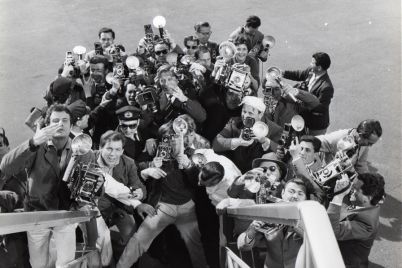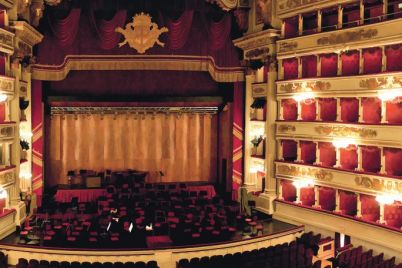Guido Nincheri was one of the most prolific Canadian artists of his generation. Emigrating to Montreal with his wife in 1913 on the eve of World War I, he quickly established himself as a masterful painter and stained glass artist. His legacy of hundreds of commissioned works includes the decoration of dozens of churches throughout North America. Saint-Viateur d’Outremont Church on the island of Montreal, consecrated in the same year that Nincheri arrived in the city, is one such work. The symbolism of one of its most famous paintings, “The Blind Leading the Blind,” which hangs in the transept, is discussed in this article.
“The Blind Leading the Blind” was executed by Guido Nincheri in 1929, and clearly expresses the artist’s sensitivity to the effects of World War I on all those who were impacted by it. This is evidenced in the commanding role of the sightless young man, and in the pained expression on the artist’s face behind the group, as he looks away. Like many artists, Nincheri occasionally included his self-portrait in his paintings to convey a message. The case can be made that what is being represented is not just physical blindness, but blindness in a spiritual and rational sense.
The scene depicts Jesus leaving Jericho on his final journey to Jerusalem. According to the Gospel of Mark and Matthew, upon encountering the two blind men, Jesus heard their cry, “O Lord, son of David, have mercy on us.” Having compassion on them he leaned over and cured them.
Superimposed on this scene is a group of blind men, which symbolize the social conditions of the artist’s time and the result of human decisions. It is a message that permeates throughout history and can be applied to our present situation of rapid social and technological development.
The painting is divided into six sections that are united by a series of parables reflecting Jesus’ life and teachings as read in the four Gospels. These are: the natural landscape and the buildings of Jericho; the crowd exiting Jericho to follow Jesus; the central grouping of the blind leading the blind; the figure of Jesus curing the blind men who waited outside of the walls of Jericho; and the praying woman and a young boy leading a donkey, carrying his two blind siblings.
Jericho is an oasis in the Jordan Valley 237 meters below sea level. An underground spring has provided irrigation for thousands of years, leading to the development of farmland on its rich alluvial soil. The region during Roman times was known for the production of date palms, wine, spices, and rare aromatic plants such as persimmon whose perfume in Roman times was considered to drive men wild.
Seen in the painting, in front of the town, are palm trees. Along the road from Jericho, behind the group of the blind men, is a grove of sycamore trees that were an important source of food mentioned in the Old Testament. Tea made from its leaves was believed to have healing qualities, and its sap was like maple syrup. Its gigantic canopy and trunk provided refuge for men and animals. Further in the background is a stand of eucalyptus trees, which are noted for their medicinal properties. In the distance, the land is dominated by mountains, while the lowlands show farming activity through the presence of fence posts.
The profile of the city shows elaborate architecture, pointing to its reputation as the residence of the Jerusalem aristocracy. It is believed that at the time Jericho housed 12,000 priests and Levites who served in the Temple of Jerusalem. During the reign of King Herod the Great, the city and its surroundings were an important agricultural, commercial and administrative centre, connected to Jerusalem by a 28-kilometer road.
The beauty of the Jericho valley, as it is depicted, is a metaphor for man’s use of the natural world and a lesson of the importance to safeguard nature rather than misuse it, which we do, at our own peril.
In biblical accounts by Matthew and Luke we learn of the reaction by some to the two blind men and to the tax collector Zacchaeus who welcomed Jesus in his home. These range from the annoyed to the critical. What people wanted, it seems, was to see miracles. They did not understand Jesus’ message of love, acceptance, forgiveness, tolerance, and inclusiveness. The parable of the sower illustrates this. The human heart is like receptive soil to the seed of the Word of God. The soil that the seed fell on represents four categories of hearers’ hearts, four different reactions to the Word of God: the hard heart, the shallow heart, the crowded heart, and the fruitful heart. To emphasize the point of understanding Jesus’ message, the man in front of the crowd points to the group of blind men, symbolizing a warning to people who follow individuals who follow false ideas.
In inserting the group of blind men leading the blind, Guido Nincheri subtly refers to the consequences of irresponsible men giving directives whose results will lead to disaster. To illustrate the point, Nincheri uses the analogy of the Pharisees. They were so overly concerned with the rituals of the Temple and the observance of the rules of external behavior, such as dietary laws, that they did not live up to what they taught. Thus, they stood in the way of understanding simple truths about man and God. “They are blind leaders of the blind. And if the blind lead the blind, both will fall into a ditch,” according to Matthew.
The young man leading the group symbolizes the many soldiers who had gone to war in 1914, believing in heroism and the nobility of warfare. Their wartime experience changed these ideals to anger and disbelief in the older generation, when their great sacrifice brought little in return. They represent the youth of all ages who follow political leaders, only to be disillusioned.
To quote the introduction to Barbara W. Tuckman’s The March to Folly (1984), “A phenomenon noticeable throughout history, regardless of place or period, is the pursuit by governments of policies contrary to their own interests. Mankind, it seems, makes a poorer performance of government than of almost any other human activity. In this sphere, wisdom, which may be defined as the exercise of judgment acting on experience, common sense and available information, is less operative and more frustrated than it should be. Why holders of high office so often act contrary to the way reason points and enlightened self-interest suggests? Why does intelligent mental process seem so often not to function?”
Roger Boccini Nincheri is Guido Nincheri’s grandson. Since retiring from teaching in 2002, he has photographed Guido Nincheri’s work in 128 churches. He has written extensively on the iconography of his grandfather’s art. He is collaborating with the Chateau Dufresne-Nincheri in Montreal to develop the Guido Nincheri Studio into an art museum.




